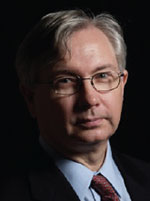The Evolution of State's Mental Health Services
MED’s mental health program has grown and evolved over the years to address the unusual needs of FS employees and their families serving overseas.
BY SAMUEL THIELMAN
When kidnapped Ambassador Adolph “Spike” Dubs died during a shootout in Kabul on Feb. 14, 1979, Elmore Rigamer, the newly hired embassy psychiatrist, spent large amounts of time with members of the community helping to heal the wounds of the trauma. Rigamer’s efforts paid significant dividends to the community and the State Department. In the violent years that followed, the department began to use mental health personnel more extensively, expanding a domestic employee assistance program and developing a number of strategies to address mental health problems overseas.
Often organizational mental health services, as well as general medical services, lie in the domain of human resources, and that is where physicians were located organizationally when the State Department’s Health Branch (as the Office of Medical Services was originally called) came into being in 1947. Interestingly, two years later, a study of the utilization of medical services overseas showed that “emotional problems” was the third-largest expense, behind surgical intervention and gastrointestinal diseases. And in 1950 the Health Branch estimated that 60 percent of patients who came to embassy health units were experiencing emotional rather than primary physical problems.
The State Department’s current approach to mental health support took shape during the 1960s and 1970s in response to two major requirements. First, the department is mandated by 22 Code of Federal Regulations 11.1 to ensure that employees posted overseas are free of any “physical, neurological or mental condition of such a nature as to make it unlikely that [they] would be able to function on a worldwide basis.” To implement this, the State Department must engage a group of mental health professionals who can assess employees for problem conditions—this is the medical clearances, or administrative, side of the house.
Second, the Foreign Service Act requires that the department make provision for treating medical conditions—including psychiatric illnesses—that emerge during service overseas. Because a large proportion of overseas health problems have a psychological component, mental health personnel posted abroad offer a first line of support to treat employees, keep them productive and reduce the likelihood of a mental health medevac—this is the mental health services, or clinical, side of the house.
The notion of offering any sort of mental health counseling “in house” was new, so it took some time to implement.
From the outset, this duality of function has posed a challenge to program development (e.g., funding, contractors vs. direct-hires, confidentiality issues), and it remains a source of confusion and mistrust today among the program’s principal beneficiaries, the members of the U.S. Foreign Service. Yet despite shortcomings and inadequacies at some times and in some places, the program has grown and evolved over the years in response to the ongoing need for mental health support for employees and their families serving abroad.
MED’s mental health program is unique among the world’s diplomatic services. Given the continuing need and the proliferation of new and more flexible models of care, MHS is poised to take new and innovative steps in the near future.
Substance Abuse and First Efforts
During the 1960s and 1970s, the Johnson, Nixon and Carter administrations all provided significant funding for mental health care in the federal government. The State Department took advantage of this to create and expand its domestic substance abuse and employee assistance programs. These programs received support initially through special federal funds designated for treatment of adolescents. Subsequently, legislation mandating such programs for the federal workplace generally led to development of MED’s Alcohol and Drug Awareness Program as we know it today. It was the department’s first substance abuse program, established in 1966 under a non-psychiatrist, Dr. Benedict Lanahan, who worked with local psychiatrists to provide treatment for members of the Foreign Service and their families who suffered from alcohol abuse.
In 1971, the State Department retained its first direct-hire psychiatrist to function in a clinical capacity. Frank K. Johnson, from Milwaukee, Wisconsin, a psychiatrist specializing in treating adolescents, became the Drug Abuse Program coordinator. Though based in Washington, Johnson traveled abroad, coordinating his work with the Office of Overseas Schools and focusing especially on the emerging problem of substance abuse among teenagers. Much of his work took place over the telephone, but he also established a departmental “youth development team” that traveled with him overseas, dealing with children, their families and overseas schools. In 1981, Johnson told a reporter from Psychiatry News that on one particularly harrowing day he had seen 17 families between 7 a.m. and midnight.
Two years after Johnson began working in the Office of Medical Services, in 1973, State hired its first full-time psychologist, Clark Slade. Slade had acquired a great deal of experience working with Foreign Service families during 15 years as a consultant to the American Foreign Service Association on child and adolescent issues. Under Frank Johnson, Slade began to do casework involving short-term therapeutic interventions for members of the Foreign Service. This arrangement worked well as a means of dealing with employees and family members with all sorts of mental health and school problems. Cases requiring lengthy treatment were referred outside the department.
Between 1979 and 1982, mental health positions were established in Vienna, Bangkok, Monrovia and Cairo.
The notion of offering any sort of mental health counseling “in house” was new, so it took some time to implement. In 1976, the State Department created a position to oversee the alcohol abuse and general mental health programs, hiring Herbert C. “Pat” Haynes, a Civil Service psychiatrist, as assistant medical director for Mental Health Services. Haynes worked at developing a coherent program that relied more on direct-hire mental health staff than on contractors.
Haynes also hired a psychologist, Dr. Samuel Karson, whose particular skills and extensive experience in personality testing were well-suited to the department’s growing need for experts in clearances in the 1980s. (From the 1950s to the mid-1970s, the clinical backbone of the department’s mental health clearance section had been a group of six private-practice psychiatrists from Washington who came into the department for an hour once a week to do evaluations for the Office of Medical Services.)
The Field Mental Health Officer
During the 1970s, another innovation in the use of overseas mental health personnel occurred that ultimately resulted in the regional medical officer/psychiatrist (RMO/P) program. Specifically, in 1974 Embassy Kabul decided to deal with a rash of mental health crises (including three suicide attempts) by using post funds to hire a psychologist, Dr. Richard Westmaas, as a personal services contractor to establish a practice at the embassy. His work was so helpful that the department employed him as a direct-hire Foreign Service employee and made him the regional mental health officer for Afghanistan, India and Pakistan.
By the time Westmaas left his position in 1977, the idea of a regional mental health officer had proven itself, and he was succeeded by former Peace Corps psychiatrist, Dr. Elmore Rigamer. Like Westmaas, Rigamer proved his worth. During his second year in Kabul, the Dubs assassination occurred, devastating the entire embassy community. Rigamer met with members of the community to discuss the psychological impact of the event, providing vital assistance to the community’s recovery from the trauma. By the time he left Kabul to continue regional psychiatry in New Delhi in 1979, the Foreign Service psychiatry program was off and running.
Between 1979 and 1982, mental health positions were established in Vienna, Bangkok, Monrovia and Cairo. Although the Bangkok position was first occupied by a psychologist, Sam Karson’s two-year tour as a regional mental health officer in Thailand (1981-1983) was a one-off. MED preferred psychiatrists, not just because they could write prescriptions, but because they are physicians and have broader training. Thus, psychiatrists are in a position to identify (and rule out) any physical/medical issues that might be the cause of mental problems. Foreign Service mental health positions subsequently went to psychiatrists. In the RMO/P skill code, for example, the P stands for psychiatrist; there is no skill code for a Foreign Service psychologist position.
One community mental health initiative during the 1970s and 1980s that seemed to work for many embassies was the “mental health grants” program.
Funding mental health care had always been an issue, because mental health care, even more than general medical care, is fraught with confidentiality concerns. And, when the psychiatrist works for the patient’s employer, the problem of “dual agency” arises. As a result, efforts in the 1970s and early 1980s often involved support for programs located outside the immediate influence of an embassy or the State Department.
The idea of using contractors, such as Westmaas had been in Kabul, was an obvious one; because Westmaas’ position had been created with local embassy funds, it reduced the dual agency conflict. But he was soon hired directly by the department as a Foreign Service regional mental health officer, and since the 1970s mental health contractors have only rarely been used by the department.
Other Models of Care
Embassies used other models of mental health care, too. Several made use of mental health clinics for expatriates that had been set up during the 1970s in cities such as Cairo, Tehran and Kuala Lumpur. And embassy health units developed lists of local practitioners they could work with.
One community mental health initiative during the 1970s and 1980s that seemed to work for many embassies was the “mental health grants” program. Established in 1974, the program grew to more than $250,000 per year. Given out in amounts ranging from $700 to $18,000, the grants paid for educational presentations, support groups, library resources related to mental health, as well as programs related to crisis intervention and referral for therapy. The grants also paid for “preventive mental health” presentations and helped support expats and others who could be of help to the American community.
Dr. Esther Roberts, an early director of Mental Health Services (1980-1983), saw these grants as a way to extend the impact of the Foreign Service psychiatry program. In 1981, 12 grants went to posts; a year later, 29 posts received mental health grants, including tiny posts such as Gaborone. The program was very popular with posts, and in a 1983 report, Associates of the American Foreign Service Worldwide recommended: “Mental health grants should be made available more quickly to posts where tension is mounting.” Yet the mental health grant program received year-to-year funding, and was therefore vulnerable to budget cuts. It died in the mid-1980s when MED leadership changed and enthusiasm for the grants waned.
USAID’S STAFF CARE CENTER
Recognizing that a healthy workforce is essential to increased productivity and employee recruitment and retention, USAID’s Office of Human Resources launched the Staff Care Program in 2012. Staff Care aims to help every employee feel valued and to integrate resilience and wellness into the agency’s corporate culture. Staff Care offers USAID employees a variety of programs and initiatives that fall under four primary pillars: work-life, wellness, the employee assistance-resilience program and the child care subsidy program.
• WorkLife4You is Staff Care’s work-life component, providing employees and their dependents with valuable resources and expert guidance to help navigate their day-to-day responsibilities and life events. Services encompass everything from breastfeeding support to advice on schools and financial aid and elder care assessments to online discussion groups and discounts.
• The wellness component supports employees in their efforts to lead healthier lives through health risk assessments, running and walking groups, weight management programs and free access to fitness facilities.
• Staff Care’s employee assistance and resilience program is intended to strengthen personal and organizational resilience, and includes services such as confidential counseling, legal and financial consultations, and specialized coaching and training to facilitate recovery after traumatic events.
• U.S. direct-hire employees whose total adjusted gross family/household income is $89,900 or less, and who have children under age 13 or a disabled child under age 18, may qualify for the child-care subsidy program.
The Staff Care Center team includes licensed psychologists, clinical social workers and certified professional coaches. The center is located at 1101 Pennsylvania Avenue NW, Suite 531, Washington, D.C. USAID employees are welcome to utilize center resources or speak with its staff by appointment. Walk-ins are also acceptable. In addition, Staff Care runs a 24/7 telephone line that is available free of charge to both domestic and international callers.
—From the Staff Care website, www.staffcare.usaid.gov
Services for Washington-based employees were increased in the early 1980s. In May 1982, prompted by Medical Director Jerome Korcak, Under Secretary for Management Richard Kennedy established the Special Employee Consultation Service. SECS, later the Employee Consultation Service or ECS, served as the department’s internal employee assistance program, providing short-term counseling and psychotherapy support to both Civil Service and Foreign Service employees at the Department of State and USAID.
By 1994, Elmore Rigamer, the original RMO/P, had become director of the Office of Medical Services. Having recently completed a year at Harvard studying health policy, he advocated the idea of an electronic medical record and supported direct payment of private providers for mental health care as a way of reducing the stigma for patients. Rigamer had also been aware of the dual agency issues created by the mental health program and supported the need to keep mental health records separate from general medical records—a principle that fell by the wayside in the early 2000s.
He also insisted on having MED become involved in overseas clearances for children with special needs and sought to professionalize the administration of MED by hiring a Civil Service executive director with experience in health care administration. These changes, along with his idea to move physician positions from European posts to some in the developing world, proved controversial, and Rigamer departed MED in 1996.
Meanwhile, the Iran hostage crisis in 1979-1980 had created further awareness of the need for psychological support for the Foreign Service. On Feb. 14, 1979, 66 Americans were taken hostage by Iranian militants when Washington admitted the Shah of Iran to the United States for cancer treatment. Fifty-two of the hostages remained in captivity for 444 days.
State Department psychiatrists Drs. Rod Johnson, Esther Roberts, Pat Haynes and others devised and implemented a plan for the response to the Iranian hostages. Ultimately, several of the hostages did, in fact, have a difficult time adjusting to life after captivity, and MED’s response reinforced the value of behavioral health services.
The Iran hostage crisis in 1979-1980 created further awareness of the need for psychological support for the Foreign Service.
Crises Highlight the Value of Services
In the wake of the hostage crisis, the mental health program expanded further. Overseas psychiatrists viewed themselves as reducing the need for medical evacuations and as having the ability to respond to crises in ways that psychiatrists covering the world from Washington could not. The department agreed and subsequently authorized the placement of four additional psychiatrists overseas.
During the 1980s, the newly organized RMO/P group faced yet another organizational challenge: the April 18, 1983, bombing of Embassy Beirut. Though the Iran hostage crisis had been a huge event, it was a situation that lent itself to advance planning, and the psychiatrists and psychologists had expended tremendous energy in planning and implementing support for the hostages. The Beirut bombing was different: It was an unexpected catastrophic disaster with serious immediate health and mental health implications.
The Aug. 7, 1998, bombing of the U.S. embassies in Nairobi and Dar es Salaam put the demand for mental health services on yet a new trajectory, and the invasion of Afghanistan and Iraq in the early 2000s compounded the need for sophisticated services. (The story of this latter period requires its own separate treatment.)
As a result of the new pressures created by large numbers of people serving in warzones or in unaccompanied assignments, the need for mental health services in the Foreign Service is greater than ever. During the 21st century the RMO/P program has grown dramatically and now comprises some 50 licensed mental health professionals working under the umbrella of the Office of Medical Services. The overseas program relies on 24 career-appointment psychiatrists, most working in health units around the world, and five limited non-career appointment social workers in high-threat posts such as Baghdad, Kabul and Islamabad.
The department’s employee assistance program, ECS, has grown to eight social workers and one psychologist, all Civil Service employees working largely on the domestic mental health issues of the department. The Alcohol and Drug Awareness Program, the first of MED’s mental health clinical programs, has three positions.
Given the continuing need and the proliferation of new and more flexible models of care, MHS is poised to take new and innovative steps in the near future.
A Unique Program
The mental health program at the Department of State evolved in response to the unusual needs of the Foreign Service. The initial involvement of psychiatrists during the 1940s and 1950s was very much a Washington, D.C., phenomenon; the department used psychiatrists to treat personnel suffering from psychiatric disorders and to render opinions on issues related to clearances.
The State Department drew from local psychiatrists in the Washington, D.C., area who worked as consultants to the department rather than employees until the 1970s. At that time, State hired its own mental health personnel—alcohol abuse counselors, social workers, psychologists and psychiatrists—who staff the federally mandated substance abuse and employee assistance programs.
The increasing needs of stressed and distressed members of the Foreign Service during the late 1970s led to an initiative to place a Foreign Service psychiatrist overseas. Despite the fact that Foreign Service psychiatrists have proved themselves useful in a wide range of settings, the complexity of the mental health needs of employees and children in today’s Foreign Service suggests the need for considering models of care that would include a widening array of mental health providers.
The department’s adaptation of psychiatry to an organizational setting is unique in scope among the diplomatic services of the modern world; and whatever its faults, it represents a major commitment on the part of the United States government to the mental health care of the foreign affairs community.
Read More...
- Help After High-Stress Assignments by Sam Thielman (The Foreign Service Journal, December 2006)
- The World of Diplomacy and the Role of Psychiatry by Esther Roberts, M.D.
- U.S. Department of Health and Human Services
- MH Care Won’t Harm Careers in Foreign Service, Clinton Says by Mark Moran (The American Psychiatric Association, October 1, 2010)





